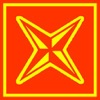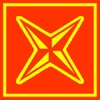sternstudio.at
Conan Dynes
new paintings
Opening on September 7th 2017, 7 p.m.
Visit by appointment until September 26th, 2017
Chicken or the egg?
An Irish comedian tells the joke where he is standing watching the London marathon and a runner, dressed up like a chicken, runs past him. 2 minutes later another runner, dressed up as an egg, runs past. He thinks to himself ‘this is going to be interesting.’
Vienna is a city of signs.
Some street signs catalog the geography of the city; the number on the street sign identifies the district. An older colour-coded sign subtly imparts its owning Bezirk. Red on white is the 1st. Others are historical signifying a spot in Vienna’s past; a plaque commemorate a place where a composer lived, a black sign on another building registers the history of a bombing and rebuilding, the poignant brass tiles on the ground document a lost section of Vienna. Some street names allow a glimpse of their past use, Salztorgasse, a gate no longer in a wall long gone. The name of a building Karl-Marx-Hof remembers the will of the builders. Its name was changed, altering the story for a period. It was renamed back. Then there are the allegorical signs; murals, mosaics, and reliefs, adding story, imagined or real, onto muted and tinted coloured buildings in the city. The narrative of signs. All current, active, and additive to life in the city.
A Sunday walk in Vienna after a visit to the Wien museum was like putting a jigsaw together. The museum’s assembly of maps, models, and paintings are from throughout Vienna’s history. Each era of art captures a Vienna of that place and time. An earlier map gives way to a newer definition in a drawing. All their marks flicker through informing my personal mapping in my wandering. The walls of the city must have been here with its local Stubentor. The Ring was outside before. Graben, the ditch, firmly within today, lay just outside the wall in another time.
There is a painting in the museum by Franz Geffels, Die Entsatzschlacht vor Wien am 12. September 1683, that presents the breaking of the Ottoman siege of Vienna by the forces under the Polish King John Sobieski III. Vienna is in the top background with the battle raging somewhere that looks like somewhere west of the city. I try to place myself in the battle. Where would I be standing? Aligning the artwork to history places the painting at Schmelz in the 15th district. Who are these performers in the painting? Are they Lords and Kings or faceless conscripts whose story has not been heard? Did one of these men leave behind some coffee to find or perhaps, after the battle, bake the first crescent croissant in a Viennese bakery?
Vienna is defined by all of this.
The mark of a gate in a wall now removed still lies within a name that no Scot gave; a mural on a church wall on Taborstrasse depicts a defender during the Turkish Siege. It tells the etymology of the street name since 1409. Kebap König under it advertises a Dürüm for €3.80. Each sign informs, lying side by side, bordering, covered, covering, sharing, and disrupting, defining the current city and moving on.


